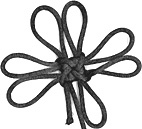 Generalities
Generalities Generalities
GeneralitiesTied on the bight, the good luck knot is somewhat fragile (eg. don't put one in your pocket and expect it to come out unscathed), but used where appropriate and reinforced when necessary, it is extremely decorative and easily varied with nice effects.
The good luck knot is different from most of the other knots with multiple ears in that there are double the number of ears than the size number of the knot would indicate. The 4-knot has 8 ears, 4 short and 4 long. But, of course, ear size is subject to the whims of the knot tyer so basing terminology on that would be foolish. However, notice that what is traditionally the "long" ear comes out of the side of the knot and the "short" ear wraps around the corner of the knot. Just because I can't leave well enough alone, I will point out that when you have a bigger knot (with more sides) the corner and sides get more diffcult to distinguish, but in this instance I doubt that mathematical terminology, like "verticies" and "edges", is going to help.
The knot in question was reportedly a "nameless orphan" until Ms. Chen named it the Good Luck Knot. The Chinese name, 吉祥結, machine translates as "auspicious knot", so apparently it was a nameless orphan in Chinese as well as English (if we don't want to count "a four-looped knot with a double square crown" as a proper name 8). The Japanese and Korean names (chrysanthemum and one mind, respectively) do not appear to be varations on the good luck theme, so one is tempted to assume that it was named in those disciplines prior to its naming in Chinese. Perhaps its identification in Chinese prior to Ms. Chen's christening was of the four-looped knot with... variety. 8)

I've been blogging about my own experiments with variations on the good luck knot. Eventually, I will make step-by-step how tos for each as would be appropriate. Until then, see the pictures and read about what I was thinking at the time (sorry if some of them sound like Freestyle Skiing manoeuvers 8):
 Some colour
variations.
Some colour
variations. the chrysanthemum
variation
the chrysanthemum
variation a rotational
variation
a rotational
variation the triangular
(3) good luck knot
the triangular
(3) good luck knot the pentagonal
(5) good luck knot
the pentagonal
(5) good luck knot the hexagonal
(6) good luck knot
the hexagonal
(6) good luck knot an incomplete
instructions for the hexagonal good luck knot
an incomplete
instructions for the hexagonal good luck knot the heptagonal
(7) good luck knot
the heptagonal
(7) good luck knot the
octagonal
(8) good luck knot
the
octagonal
(8) good luck knot the nonagonal
(9) good luck knot
the nonagonal
(9) good luck knot You might ask yourself: what happens if I flip the knot back to
front after the first crown? Well, your corner ears get folded
under and hidden, leaving what looks more or less like a standard
good luck knot with only side ears. Let's call it the reverse
crown luck knot.
You might ask yourself: what happens if I flip the knot back to
front after the first crown? Well, your corner ears get folded
under and hidden, leaving what looks more or less like a standard
good luck knot with only side ears. Let's call it the reverse
crown luck knot. square inset
ears luck knot
square inset
ears luck knot square
inset flower ears luck knot
square
inset flower ears luck knot square
corner split luck knot
square
corner split luck knot square
corner cross twist split luck knot
square
corner cross twist split luck knot square
reverse corner split luck knot
square
reverse corner split luck knot square
corner crown luck knot
square
corner crown luck knot square
corner counter crown luck knot
square
corner counter crown luck knot square
reverse corner crown luck knot
square
reverse corner crown luck knot square
reverse corner counter crown luck knot
square
reverse corner counter crown luck knot
Creation Date: Mon Feb 16 23:59:44 PST 2009
Last Modified: Sunday, 20-Jun-2010 00:49:08 UTC
Page accessed at local time: Monday, 30-Jun-2025 23:07:41 UTC